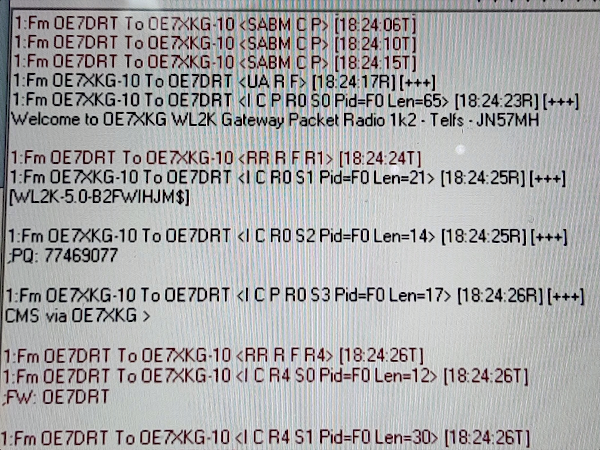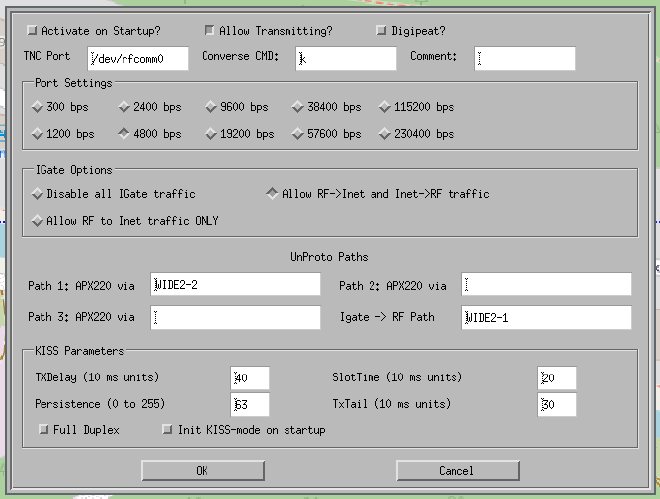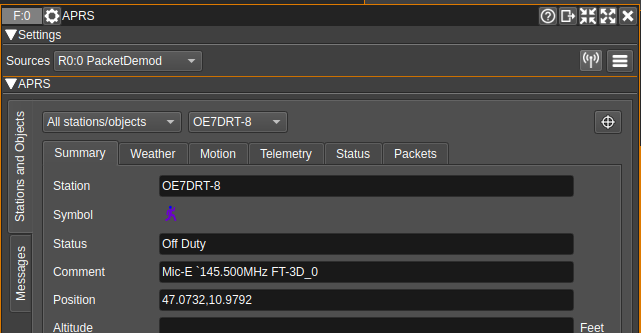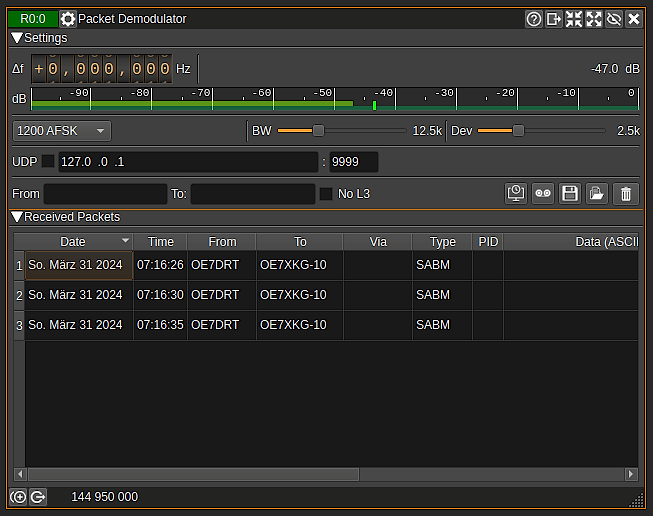Packet radio, VARA (FM+HF), Mobilinkd, Digirig and the SignaLink USB on Linux

Table of Contents
Out of curiosity I began another “research-session” because it is really time to get that Winlink back on my Linux laptop (I used OpenBSD on this machine for some months now and I haven’t got a single chance to get wine onto that) – I will stay Linux for a while I guess.
I’ve been using a Surface 2 Go for some time (well, a really short time) but ditched it again because I wasn’t really satisfied with its performance.
There are several different devices and software solutions to send winlink messages and I won’t cover all of them. The following examples exist because I own the necessary devices and I already have the software to work with them.
I would choose the Digirig as my favourite device because it just works every time and it also provides a USB soundcard to the computer (like the SignaLink USB).
Digirig #
The Digirig gets controlled with rigctld – I use different models for the
HF and the FM rig – but the rig configuration is the same for both:
"hamlib_rigs": {
"my_rig": {
"address": "127.0.0.1:4532",
"network": "tcp"
}
},
That part of the pat configuration makes sure that pat can transmit with the radio.
Packet radio #
Using AX.25+agwpe within pat in combination with Direwolf – but this combination felt a bit slow (which might only be my subjective opinion).
Someone might want to tune direwolf for better throughput or more reliable connections, but I’m not a direwolf expert and I rarely use it in favour of VARA FM.
Besides that, I never used packetradio on HF yet. (300bps)
"ax25": {
"engine": "linux",
"rig": "",
"beacon": {
"every": 3600,
"message": "Winlink P2P",
"destination": "IDENT"
}
"agwpe": {
"addr": "127.0.0.1:8000",
"radio_port": 0
},
The agwpe section is used by Direwolf:
$ direwolf -c /etc/direwolf/direwolf.conf -p
Dire Wolf version 1.7
Includes optional support for: gpsd hamlib cm108-ptt dns-sd
Reading config file /etc/direwolf/direwolf.conf
Audio device for both receive and transmit: plughw:1,0 (channel 0)
Channel 0: 1200 baud, AFSK 1200 & 2200 Hz, A+, 44100 sample rate.
Ready to accept AGW client application 0 on port 8000 ...
Ready to accept KISS TCP client application 0 on port 8001 ...
DNS-SD: Avahi: Failed to create Avahi client: Daemon not running
Virtual KISS TNC is available on /dev/pts/8
Created symlink /tmp/kisstnc -> /dev/pts/8
The direwolf.conf file looks like this (comments removed):
ADEVICE plughw:1,0
CHANNEL 0
MYCALL OE7DRT
MODEM 1200
PTT /dev/ttyUSB0 RTS DTR
AGWPORT 8000
KISSPORT 8001
IGTXLIMIT 6 10
Direwolf will warn you if the input audio level is way off; I adjust them
with the program alsamixer (F6 to select the USB soundcard,
then F5 to list all devices, disable Auto Gain Control with m
(mute)).
Direwolf handles the PTT via the RTS line of the Digirig.
VARA FM #
This section has been updated on 2 May 2025.
I have already asked the author of VARA-FM for some changes regarding the selection
of the COM ports used for PTT to make this a bit more user-friendly but unfortunately
the used comport.ocx library is limited to 16 ports.
I would suggest Option #2:
using a COM port within VARA-FM and changing the assignment of COM ports within
the wine windows registry.
PTT via rigctld #
The corresponding configuratoin in the pat config file:
"varafm": {
"addr": "127.0.0.1:8300",
"bandwidth": 0,
"rig": "my_rig",
"ptt_ctrl": true
},
Start rigctld with a Dummy model - just to use the USB port
of the Digirig for PTT:
$ rigctld -m 1 -p /dev/ttyUSB0 -P RTS -s 9600 -vvvv
I start VARA FM by running a small script called varafm.sh:
#!/usr/bin/sh
# Start VARA via wine
WINEPREFIX=/home/dominic/.wine-winlink wine "C:\\VARA FM\\VARAFM.exe"
In VARA FM set the USB soundcard, adjust the volume in alsamixer and on your
radio, set PTT to VOX – I tried to use COM1 but
that crashed wine several times (that is why I set up rigctl before).
If you need to stop rigctl: you can usually do that with
CTRL + C but this might not work. So either stop the running
pat process by hitting CTRL + C in the “pat terminal” or by
killing rigctld with kill $(pgrep rigctld).
PTT via COM port directly with VARA-FM #
⇒ Replacing the COM port in the VARA-FM settings file #
In this case our pat config part for VARA-FM looks like this:
"varafm": {
"addr": "localhost:8300",
"bandwidth": 0,
"rig": "",
"ptt_ctrl": false
},
But I start VARA-FM with a script that will change the PTTPort to the first USB device (that is assigned by wine usually to COM33).
#!/usr/bin/sh
# Start VARA via wine
# lastmod: 2025-01-24
#
# Author: Dominic Reich (OE7DRT)
# VARA itself can only select COM ports up to COM16, so we manually
# edit the config file so it gets to use the first USB device (/dev/ttyUSB0)
sed -i '/^PTTPort=/s/=.*$/=COM33/' ~/.wine-winlink/drive_c/VARA\ FM/VARAFM.ini
WINEPREFIX=/home/dominic/.wine-winlink wine "C:\\VARA FM\\VARAFM.exe" &
⇒ Defining a lower numbered COM port assignment within wine itself #
This way we could use COM1 or other low-numbered COM ports within VARA-FM just by selecting them in the PTT settings dialog.
We need to start the windows registry editor in our WINEPREFIX.
$ WINEPREFIX=/home/dominic/.wine-winlink wine regedit
We then move to HKEY_LOCAL_MACHINE\Software\Wine\Ports and create a new string entry with the name COM1. The value of that newly created string will be /dev/ttyUSB0 (or whatever name your USB device has).
Close the registry editor and start VARA-FM, now open the PTT settings dialog and select COM and choose the right COM port in the drop-down menu (COM1).
Adopt COM ports and device names (/dev/ttyUSB0) to your specific use case!
VARA HF #
Back to the TX-500, the pat configuration looks like:
"varahf": {
"addr": "127.0.0.1:8300",
"bandwidth": 2300,
"rig": "my_rig",
"ptt_ctrl": true
},
I start rigctld like:
$ rigctld -m 2050 -r /dev/ttyUSB0 -d /dev/ttyUSB0 -p /dev/ttyUSB0 -P RTS -s 9600 -vvv
This is for the CAT protocol Lab599. If you use the older implementation (Kenwood TS-2000) start rigctl with model 2014:
$ rigctld -m 2014 -r /dev/ttyUSB0 -d /dev/ttyUSB0 -p /dev/ttyUSB0 -P RTS -s 9600 -vvv
Mobilinkd #
Winlink #
I will use AX.25+linux in pat with the TNC4 paired via Bluetooth.
First of all, power on the TNC4 and pair it – I use blueman-manager for this.
Then we need the serial port – right click on TNC4 Mobilinkd and select Connect with Serial port
That will create a serial port at /dev/rfcomm0.
You can also create rfcomm0 in the terminal (you need the package extra/bluez-deprecated-tools for this):
$ hcitool scan Scanning ... 34:81:F4:AA:89:4F TNC4 Mobilinkd $ sudo rfcomm connect 0 34:81:F4:AA:89:4F Connected /dev/rfcomm0 to 34:81:F4:AA:89:4F on channel 1 Press CTRL-C for hangupLeave that terminal window open, if you are finished with your operation hit CTRL+C to disconnect the serial port.
$ hcitool scan Scanning ... 34:81:F4:AA:89:4F TNC4 Mobilinkd $ sudo rfcomm bind 0 34:81:F4:AA:89:4FYou can work within this terminal but you have to release the port when you are finished.
$ sudo rfcomm release 0
In order to use it in pat, we need to use kissattach on that serial device.
First we need to setup an AX.25 port called wl2k in /etc/ax25/axports:
# /etc/ax25/axports
#
# The format of this file is:
#
# name callsign speed paclen window description
#
#1 OH2BNS-1 1200 255 2 144.675 MHz (1200 bps)
#2 OH2BNS-9 38400 255 7 TNOS/Linux (38400 bps)
wl2k OE7DRT 1200 255 7 Winlink
This needs also some configuration work in the pat configuration:
"ax25_linux": {
"port": "wl2k"
},
"serial-tnc": {
"path": "/dev/rfcomm0",
"serial_baud": 9600,
"hbaud": 1200,
"type": "Kenwood",
"rig": ""
},
Now we can attach a KISS interface to the serial port:
$ sudo kissattach /dev/rfcomm0 wl2k
AX.25 port wl2k bound to device ax0
Select your PacketRadio Gateway (CALLSIGN-10 usually) and connect using AX.25+linux.
To de-attach the KISS interface we need to kill the process:
$ sudo kill $(pgrep kissattach)or
$ sudo pkill kissattach
APRS with Xastir #
Find the TNC4:
$ hcitool scan
Scanning ...
34:81:F4:AA:89:4F TNC4 Mobilinkd
Create the serial port:
$ sudo rfcomm bind 0 34:81:F4:AA:89:4F
We use /dev/rfcomm0 in Xastir.

To disconnect the device:
$ sudo rfcomm release 0
SignaLink USB #
I haven’t used this now for a while, but I wanted to include this in this list, as it provides a USB soundcard to the computer just like the Digirig does – but it does not provide a serial interface to control the PTT.
Packet radio #
Start direwolf (using the same configuration as with the Digirig), it will
complain about not finding /dev/ttyUSB0 for PTT control. I don’t use this that
often and I don’t use another USB device at the same time so I don’t care about this.
If you have another device connected as /dev/ttyUSB0 you should probably remove its
reference from the direwolf configuration file.
As mode I select AX.25+agwpe and I set the output volume of the PCM2906C Audio CODEC to 100% – the SignaLink USB will now control the PTT.
VARA FM #
Start VARA FM (I use my script mentioned above) and select the proper sound card. The input volume level can be adjusted with the volume knob on the radio and the RX knob on the SignaLink USB. The output volume level can be checked and adjusted with the tune function withing the Soundcard menu from within VARA FM. You may also try the Auto-tune function.
VARA HF #
I never tested this because I have no cable for the TX-500 and the SignaLink USB, but as the Signalink only provides a soundcard you have to add another USB cable for CAT control of the radio. You then start rigctld with the proper values for that specific radio.
Some systemd unit-file examples #
Put them into $HOME/.config/systemd/user. I created them at the
beginning of my “Linux Winlink journey” but actually I only let pat
start the webgui at boot - the other stuff I start with scripts or
I search the command history (autocomplete) in my shell.
I don’t even let pat listen to something because this is my main laptop and I like the services started in a terminal window.
pat #
[Unit]
Description="pat winlink"
After=network.target rigctld.service ardopc.service
Wants=rigctld.service ardopc.service
[Service]
Type=simple
ExecStart=/home/dominic/bin/pat --listen "ardop,telnet" http
TimeoutSec=10
[Install]
WantedBy=default.target
rigctld #
[Unit]
Description="rigctld for TX-500 using Digirig"
After=network.target
Before=pat.service ardopc.service
[Service]
Type=simple
; -m 2050 for Lab599 TX-500 CAT protocol
; ExecStart=/usr/bin/rigctld -m 2050 -r /dev/ttyUSB0 -p /dev/ttyUSB0 -P RTS -s 9600 -vvvv
; -m 2014 for Kenwood TS-2000 CAT protocol
; ExecStart=/usr/bin/rigctld -m 2014 -r /dev/ttyUSB0 -p /dev/ttyUSB0 -P RTS -s 9600 -vvvv
ExecStart=/usr/bin/rigctld -m 2014 -r /dev/ttyUSB0 -d /dev/ttyUSB0 -p /dev/ttyUSB0 -P RTS -s 9600 -vvvv
TimeoutSec=10
[Install]
WantedBy=default.target
You can change the used protocol (Kenwood TS-2000 or Lab599 TX-500 for CAT control within the menu on the TX-500 (last menu setting)).
ardopc #
[Unit]
Description="ardopc for TX-500 using Digirig"
After=network.target
Before=pat.service
[Service]
Type=simple
; ExecStart=/home/dominic/bin/ardopc 8515 hw:1,0 hw:1,0 -c /dev/ttyUSB0:9600 -p /dev/ttyUSB0:9600
ExecStart=/home/dominic/bin/ardopc 8515 plughw:1,0 plughw:1,0
TimeoutSec=10
[Install]
WantedBy=default.target
Maybe hw:… works better, but I had less trouble when using plughw:….
Decoding other stations #
APRS #
With direwolf #
This also sends a beacon and the received stations to APRS-IS. You can watch it on https://aprs.fi.
$ rtl_fm -M fm -f 144.8M -p 36 -s 24000 -g 42 - | direwolf -c sdr-1200bps.conf -r 24000 -D 1 -B 1200 -
The direwolf configuration:
ACHANNELS 1
ADEVICE null null
CHANNEL 0
MYCALL {callsign}
IGLOGIN {callsign} {passcode}
IGSERVER rotate.aprs2.net
MODEM 1200
AGWPORT 8000
KISSPORT 8001
PBEACON sendto=IG delay=0:30 every=30:00 symbol="igate" overlay=R lat=X long=Y alt=in_meter comment="144.8MHz Receive-only gateway AFSK 1200bps"
IGTXLIMIT 6 10
With multimon-ng #
$ rtl_fm -f 144.8M -g 42 -s 22050 -l 20 - | multimon-ng -t raw -a AFSK1200 -
With sdrangel #
Add a channel and select Packet Demoulator.
Once packet gets demodulated, add a feature and select APRS:


The APRS feature windows let you connect to APRS-IS (top right of the APRS window).
You can also add another feature called Map to display the received APRS packets on a map.

Packet radio #
With direwolf #
$ rtl_fm -f 144.950M -M fm -s 200000 -r 32000 -g 35 | direwolf -n 1 -r 32000 -b 16 -t 0 -
$ rtl_fm -M fm -f 144.950M -s 22050 | direwolf -n 1 -r 22050 -b 16 -
With sdrangel #
Add a channel and select Packet Demoulator.

VARA HF #
We can only decode with VARA HF in monitor mode. It is possible that we can’t decode anything.
POCSAG #
With multimon-ng #
$ rtl_fm -M fm -f 438.025M -s 22050 | multimon-ng -t raw -a POCSAG512 -a POCSAG1200 -a POCSAG2400 -a FLEX -f alpha -
With sdrangel #

Set the frequency to 438.025 MHz (in Austria) and add a channel (pink mark box). Select Pager Demodulator and start decoding (click the Play button).
That will decode the set POCSAG modulation (defaults to 1200 baud).
